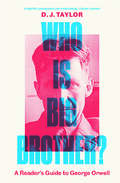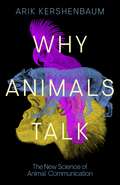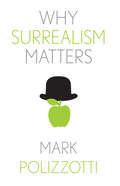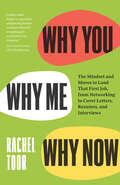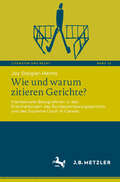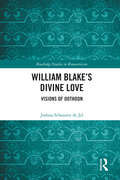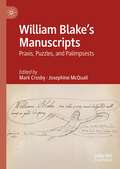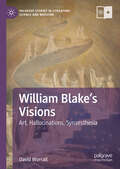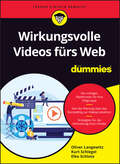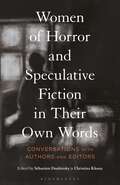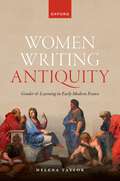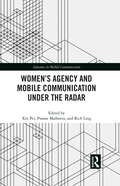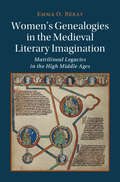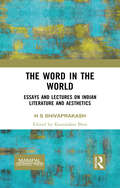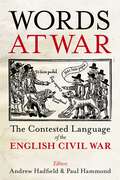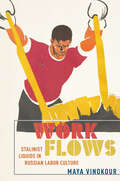- Table View
- List View
Who Is Big Brother?: A Reader's Guide to George Orwell
by D. J. TaylorA spirited and essential companion to Orwell and his works, covering all the novels and major essays An intellectual who hated intellectuals, a socialist who didn’t trust the state—our foremost political essayist and author of Animal Farm and Nineteen Eighty-Four was a man of stark, puzzling contradictions. Knowing Orwell’s life and reading Orwell’s works produces just as many questions as it answers. Celebrated Orwell biographer D. J. Taylor guides fans and new readers alike through the many twists and turns of Orwell’s books, life and thought. As a writer he intended his works to be transparent and instantly accessible, yet they are also full of secrets and surprises, tantalising private histories, and psychological quirks. From his conflicted relationship with religion to his competing anti-imperialism and fascination with empire, Who Is Big Brother? delves into the complex development of this essential yet enigmatic voice. Taylor leads us through Orwell’s principal writings and complex life—crafting an illuminating guide to one of the most enduringly relevant writers in the English language.
Why Animals Talk: The New Science of Animal Communication
by Arik Kershenbaum‘Wonderful . . . Endlessly interesting and beautifully written’ DAILY TELEGRAPH ‘Steady-headed and fun’ SUNDAY TIMES‘Read this book and, I promise, you’ll never listen to animals in the same way again’ JESSICA PIERCE, author of Who’s a Good Dog?Why Animals Talk is a scientific journey through the untamed world of animal communication. From the majestic howls of wolves and the enchanting chatter of parrots to the melodic clicks of dolphins and the spirited grunts of chimpanzees, these diverse and seemingly bizarre expressions are far from mere noise. In fact, they hold secrets that we are just beginning to decipher.For example, wolves – just like humans – possess unique accents that distinguish their howls, and not only do dolphins give themselves names, but they also respond excitedly to recordings of the whistles of long-lost companions.Chapter by chapter and animal by animal, Kershenbaum draws on his extensive research and observations of animals in the wild to explain the science behind why animals are communicating. Also revealing profound insights into our own language and why it is different, Why Animals Talks tells the comprehensive story of communication and how it works across the entire animal kingdom.‘Quirky, insightful . . . based on a deep understanding of recent research’ TIM CLUTTON-BROCK, author of Meerkat Manor‘A new look at a fascinating subject’ DESMOND MORRIS, author of The Naked Ape
Why Collingwood Matters: A Defence of Humanistic Understanding (Why Philosophy Matters)
by Dr Giuseppina D'OroR.G. Collingwood (1889-1943) was an English philosopher, historian and practicing archaeologist. His work, particularly in the philosophy of action and history, has been profoundly influential in the 20th and 21st century. Although the importance of his work is indisputable, this is the first book to consider how and why it actually matters. Giussepina D'oro considers the importance of Collingwood as a thinker who thinks kaleidoscopically and, unlike lots of contemporary philosophers, refuses to focus on narrow, technical interests but instead, observes the whole world of thought. Why Collingwood Matters revives Collingwood's conception of the role and character of philosophical analysis and shows how it informs his understanding of the mind, what it means to act, and what it means to understand the past historically. It also argues for the relevance of his metaphilosophical approach to the challenge posed by the Anthropocene and the global environmental crisis. Both an elucidation of Collingwood's thought and a lively exploration of it's contemporary relevance, Why Collingwood Matters provides a much-needed examination of a 20th-century polymath.
Why Surrealism Matters (Why X Matters Series)
by Mark PolizzottiAn elegant consideration of the Surrealist movement as a global phenomenon and why it continues to resonate Why does Surrealism continue to fascinate us a century after André Breton’s Manifesto of Surrealism? How do we encounter Surrealism today? Mark Polizzotti vibrantly reframes the Surrealist movement in contemporary terms and offers insight into why it continues to inspire makers and consumers of art, literature, and culture. Polizzotti shows how many forms of popular media can thank Surrealism for their existence, including Monty Python, Theatre of the Absurd, and trends in fashion, film, and literature. While discussing the movement’s iconic figures—including André Breton, Leonora Carrington, Salvador Dalí, René Magritte, Man Ray, and Dorothea Tanning—he also broadens the traditionally French and male-focused narrative, constructing a more diverse and global representation. And he addresses how the Surrealists grappled with ideas that mirror current concerns, including racial and economic injustice, sexual politics, issues of identity, labor unrest, and political activism. Why Surrealism Matters provides a concise, engaging exploration of how, a century later, the “Surrealist revolution” remains as dynamic as ever.
Why We Need Russian Literature: Tolstoy, Dostoevsky, Chekhov and Others (Russian Shorts)
by Angela BrintlingerFor nearly two centuries readers all over the world have turned to the great canon of Russian literature. Love and death, war and peace, yes, even crime and punishment; readers across the globe have found in Russian writing a substantial measure of intellectual provocation, aesthetic pleasure, emotional resonance, and personal solace. Why We (Still) Need Russian Literature explores the familiar names of Pushkin, Tolstoy, Dostoevsky and Chekhov to connect readers with these experiences. With a lively, jargon-free style and insightful analyses of thought-provoking texts, this concise volume helps you to understand more fully the pleasure to be found in reading, and re-reading. By identifying what readers seek and find in Russian books-from aesthetically pleasing descriptions to apt psychological renderings-Angela Brintlinger aims to enhance the gratification of reading, giving armchair travelers an excuse to embark on a series of fascinating journeys. Drawing on Brintlinger's experiences as a scholar, teacher, and reader of literature, the book is informed by a deep cultural understanding of Russia and Russians. It reveals this through engaging literary meditations that connect Russian literature to the losses, ironies, and ambiguities that define the human condition. Exploring authors' imagined readers as well as authors themselves, Brintlinger argues that it is these readers, from all over the world, who get to decide what literary works are worth reading. As a bonus, she offers an appendix with more names and titles, familiar and perhaps utterly new-books that show the ways in which Russian literature remains vital today.
Why You, Why Me, Why Now: The Mindset and Moves to Land That First Job, from Networking to Cover Letters, Resumes, and Interviews
by Rachel ToorA clear, accessible, and fun guide on everything it takes to land a job. Searching for a job can be hard and demoralizing work. In Why You, Why Me, Why Now, Rachel Toor delivers some good news. The most important thing is within your control—a mindset that shows you know the goals of the organization you want to work for and that you’re ready and eager to contribute. Toor provides, with compassion and enthusiasm, strategies to make it easy for hiring managers to say “yes.” Through useful and funny anecdotes, she offers advice from professionals across industries and focuses on the attitude applicants can adopt to find success. Revealing traits employers seek, Toor shows how to craft winning cover letters, ways to tailor resumes for each job, and practical tips to get past AI screening. She also explains how to use LinkedIn and gives tips on preparing for interviews. Throughout, the book features Toor’s notes on writing well to help in landing a first job and beyond. Encouraging, entertaining, and blunt, this is a job-search guide like no other.
Wie und warum zitieren Gerichte?: Intertextuelle Bezugnahmen in den Entscheidungen des Bundesverfassungsgerichts und des Supreme Court of Canada (Literatur und Recht #12)
by Joy Steigler-HermsGerichtsentscheidungen können ohne Bezugnahmen auf andere Texte weder getroffen noch verfasst werden, Zitate sind in Gerichtsentscheidungen omnipräsent. Jede Entscheidung berücksichtigt einschlägige Normtexte oder Präjudizien, in erster Linie zur Sicherstellung einer kohärenten Rechtsprechung. Durch den Akt des Bezugnehmens demonstrieren Gerichte, dass sie in ihren Entscheidungen auf einer etablierten Rechtsdogmatik aufbauen. Diese Integration in die bestehende Dogmatik legitimiert die Entscheidung und schafft damit Rechtssicherheit durch Rechtsvorhersagbarkeit. In Gerichtsentscheidungen finden sich darüber hinaus Bezugnahmen auf Texte, die nicht über rechtliche Autorität verfügen und denen entsprechend keine derartige Funktion zugeschrieben werden kann. Unter den von Gerichten zitierten Quellen finden sich neben Gesetzestexten z.B. auch Bezüge auf ausländisches Recht, auf wissenschaftliche Quellen oder sogar auf literarische Texte. Die vorliegende Arbeit beschäftigtsich in Anbetracht dessen mit der Frage, wie und warum Gerichte zitieren. Am Beispiel von Entscheidungen des Bundesverfassungsgerichts und des Supreme Court of Canada schlägt die interdisziplinäre Studie sowohl philologische als auch rechtswissenschaftliche Auswertungskriterien zur empirischen Rekonstruktion von Zitatfunktionalisierungen vor und nimmt dabei ferner auch eine komparative Perspektive auf rechtskreisbedingte Unterschiede zwischen den Zitationspraktiken vor Gericht ein.
Wilhelm von Humboldt and Early American Linguistics: Resources and Inspirations
by null Emanuel J. DrechselWilhelm von Humboldt (1767–1835), an early pioneer in the philosophy of language, linguistic and educational theory, was not only one of the first European linguists to identify human language as a rule-governed system –the foundational premise of Noam Chomsky's generative theory – or to reflect on cognition in studying language; he was also a major scholar of Indigenous American languages. However, with his famous naturalist brother Alexander 'stealing the show,' Humboldt's contributions to linguistics and anthropology have remained understudied in English until today. Drechsel's unique book addresses this gap by uncovering and examining Humboldt's influences on diverse issues in nineteenth-century American linguistics, from Peter S. Duponceau to the early Boasians, including Edward Sapir. This study shows how Humboldt's ideas have shaped the field in multiple ways. Shining a light on one of the early innovators of linguistics, it is essential reading for anyone interested in the history of the field.
Will It Pop?: Phase 2 Set 5 (big Cat Phonics For Little Wandle Letters And Sounds Revised)
by Jane Langford Collins Big CatWilliam Blake’s Divine Love: Visions of Oothoon (Routledge Studies in Romanticism)
by Joshua Schouten de JelDespite the fact that William Blake summarises the plot of Visions of the Daughters of Albion (1793) in just eight lines in the prefatory ‘Argument,’ there are several contentious moments in the poem which continue to cause debate. Critics read Oothoon’s call to Theotormon’s eagles and her offer to catch girls of silver and gold as either evidence of her rape-damaged psyche or confirmation of her selfless love which transcends her socio-sexual state. How do we reconcile the attack of Theotormon’s eagles and the wanton play of the girls with Oothoon’s articulate and highly sophisticated expressions of spiritual truth and free love?In William Blake’s Divine Love: Visions of Oothoon, Joshua Schouten de Jel explores the hermeneutical possibilities of Oothoon’s self-annihilation and the epistemological potential of her visual copulation by establishing an artistic and hagiographical heritage which informs the pictorial representation and poetic pronunciation of Oothoon’s enlightened entelechy. Working with Michelangelo’s The Punishment of Tityus (1532) and Gian Lorenzo Bernini’s Ecstasy of Saint Teresa (1647–51), Oothoon’s ecstatic figuration reflects two iconographic traditions which, framed by the linguistic tropes of divine love expressed within a female-centred mystagogy, reveal the soteriological significance of Oothoon’s willing self-sacrifice.
William Blake’s Divine Love: Visions of Oothoon (Routledge Studies in Romanticism)
by Joshua Schouten de JelDespite the fact that William Blake summarises the plot of Visions of the Daughters of Albion (1793) in just eight lines in the prefatory ‘Argument,’ there are several contentious moments in the poem which continue to cause debate. Critics read Oothoon’s call to Theotormon’s eagles and her offer to catch girls of silver and gold as either evidence of her rape-damaged psyche or confirmation of her selfless love which transcends her socio-sexual state. How do we reconcile the attack of Theotormon’s eagles and the wanton play of the girls with Oothoon’s articulate and highly sophisticated expressions of spiritual truth and free love?In William Blake’s Divine Love: Visions of Oothoon, Joshua Schouten de Jel explores the hermeneutical possibilities of Oothoon’s self-annihilation and the epistemological potential of her visual copulation by establishing an artistic and hagiographical heritage which informs the pictorial representation and poetic pronunciation of Oothoon’s enlightened entelechy. Working with Michelangelo’s The Punishment of Tityus (1532) and Gian Lorenzo Bernini’s Ecstasy of Saint Teresa (1647–51), Oothoon’s ecstatic figuration reflects two iconographic traditions which, framed by the linguistic tropes of divine love expressed within a female-centred mystagogy, reveal the soteriological significance of Oothoon’s willing self-sacrifice.
William Blake's Manuscripts: Praxis, Puzzles, and Palimpsests
by Mark Crosby Josephine A. McQuailThis collection of essays examines how close analysis of William Blake’s manuscripts can yield new discoveries about his techniques, his working habits, and his influences. With the introduction of facsimile editions and more particularly, the William Blake Archive, the largest digital repository of Blake materials online, scholars have been able to access Blake’s work in as close its original medium, leading to important insights into Blake’s creative process and mythopoetic system. Recent advancements in digital editing and reproduction has further increased interest in Blake’s manuscripts. This volume brings together both established Blake scholars, including G.E. Bentley Jnr’s final essay on Blake, and upcoming scholars whose research is at the intersection of digital humanities, critical theory, textual scholarship, queer theory, transgender studies, reception history, and bibliographical studies. The chapters seek to cover the breadth of Blake’s manuscripts: poetry, letters, notebook entries, and annotations. Together, these chapters offer an overview of the current state of research in Blake studies on manuscripts at a point when his manuscripts have become increasingly available in digital environments, and gesture to a possible future of Blake scholarship in general.
William Blake's Visions: Art, Hallucinations, Synaesthesia (Palgrave Studies in Literature, Science and Medicine)
by David WorrallThis book is an inquiry into whether what Blake called his ‘visions’ can be attributed to recognizable perceptual phenomena. The conditions identified include visual hallucinations (some derived from migraine aura), and auditory and visual hallucinations derived from several types of synaesthesia. Over a long period of time, Blake has been celebrated as a ‘visionary,’ yet his ‘visions’ have not been discussed. Worrall draws on an understanding of neuroscience to examine both Blake’s visual art and writings, and discusses the lack of evidence pointing towards psychosis or pathological ill-health, thus questioning the rumours pertaining to Blake’s insanity.
Wirkungsvolle Videos fürs Web für Dummies (Für Dummies)
by Oliver Langewitz Kurt Schlegel Elke SchloteMithilfe von Videos das Netz begeistern Videos bieten Ihnen die Möglichkeit, eigene Ideen zu vermitteln oder Ihre Marke zu präsentieren. Wie Sie wirkungsvolle Videos fürs Web erstellen und was Sie bei der videobasierten Kommunikation beachten müssen, erfahren Sie in diesem Buch. Oliver Langewitz, Kurt Schlegel und Elke Schlote erklären Ihnen in praktischen Schritten, wie Ihnen die Planung, Erstellung und Verbreitung von Videos fürs Web optimal gelingt. Dabei lernen Sie auch die Besonderheiten der verschiedenen Internetplattformen kennen und wie Sie Ihre Zielgruppe mit Ihren Inhalten abholen. Sie erfahren Wie Sie professionelle Webvideos produzieren Wie Sie in Ihren Videos wirksame Geschichten erzählen Welche Online-Kanäle für Ihre Videos wichtig sind Wie es Ihnen gelingt, mit Ihren Videos eine breite Community zu erreichen
Women of Horror and Speculative Fiction in Their Own Words: Conversations with Authors and Editors
by Sébastien Doubinsky and Christina KkonaWhat makes science fiction genres better than others at challenging social conventions, especially gender? Are speculative works structured differently when addressed to traditionally under-portrayed individuals or communities?This collection of interviews elicits truly honest and thought-provoking responses that focus on the biographical dimension in speculative fiction, questions of intersectionality, genre (re)definitions and the politicization of fiction. It gives voice to women of different races, nations, classes and sexual orientations who write and edit speculative fiction – such as Ellen Datlow, Kathe Koja, Angela Mi Young Hur, Eugen Bacon, and Cat Rambo. The interviews clarify how the junction of genre and gender is a key element to understanding this literary field, while simultaneously contextualizing and theorizing the interview itself, as a literary genre and a research tool.
Women Writing Antiquity: Gender and Learning in Early Modern France
by Helena TaylorWomen Writing Antiquity argues that the struggle to define the female intellectual in seventeenth-century France lay at the centre of a broader struggle over the definition of literature and literary knowledge during a time of significant cultural change. As the female intellectual became a figure of debate, France was also undergoing a shift away from the dominance of classical cultural models, the transition towards a standardized modern language, the development of a national literature and literary canon, and the emergence of the literary field. This book explores the intersection of these phenomena, analyzing how a range of women constructed the female intellectual through their reception of Greco-Roman culture. Women Writing Antiquity offers readings of known and less familiar works from a diverse corpus of translators, novelists, poets, linguists, playwrights, essayists, and fairy tale writers, including Marie de Gournay, Madeleine de Scud?ry, Madame de Villedieu, Antoinette Deshouli?res, Marie-Jeanne L'H?ritier, and Anne Dacier. Challenging traditionally formalist and source-text orientated approaches, the study reframes classical reception in terms of authorial self-fashioning and professional strategy, and explores the symbolic value of Latin literacy to an author's projected identity. These writers used reception of Greco-Roman culture to negotiate the value attributed to different genres, the nature of poetics, the legitimacy of varied modes of authorship, the qualities and properties of French, and even how and by whom these topics might be debated. Women Writing Antiquity combines a new take on the literary history of the period with a retelling of the history of the figure of the 'learned woman'.
Women’s Agency and Mobile Communication Under the Radar (Advances in Mobile Communication)
by Xin Pei Pranav Malhotra Rich LingThis volume maps the role of mobile communication in the daily lives of women around the globe, shedding light on “under-the-radar” use of mobile communication to display a nuanced understanding of social impacts that may affect the gender construction processes of women at the individual, institutional, and societal levels. A global team of authors focus on the use of mobile communication by women in the lower rungs of their respective societies, as well as those who migrate with marginalized statuses within and across the national borders, to demonstrate how “under-the-radar” use of mobile communication is deeply inscribed within diversified social, cultural, historical, and political milieus. Illuminating the social structural constraints faced by women under their dynamic negotiation of agentic mobile phone use for self-empowerment, the chapters cover women’s economic activities, health care, well-being, migration, gendered identity, and the practices of different gender roles. This comprehensive and interdisciplinary volume will be of interest to scholars and students of media and communication, new and digital media, mobile communication, gender studies, sociology, anthropology, political science, and cultural studies.
Women’s Agency and Mobile Communication Under the Radar (Advances in Mobile Communication)
by Xin Pei Pranav Malhotra Rich LingThis volume maps the role of mobile communication in the daily lives of women around the globe, shedding light on “under-the-radar” use of mobile communication to display a nuanced understanding of social impacts that may affect the gender construction processes of women at the individual, institutional, and societal levels. A global team of authors focus on the use of mobile communication by women in the lower rungs of their respective societies, as well as those who migrate with marginalized statuses within and across the national borders, to demonstrate how “under-the-radar” use of mobile communication is deeply inscribed within diversified social, cultural, historical, and political milieus. Illuminating the social structural constraints faced by women under their dynamic negotiation of agentic mobile phone use for self-empowerment, the chapters cover women’s economic activities, health care, well-being, migration, gendered identity, and the practices of different gender roles. This comprehensive and interdisciplinary volume will be of interest to scholars and students of media and communication, new and digital media, mobile communication, gender studies, sociology, anthropology, political science, and cultural studies.
Women's Genealogies in the Medieval Literary Imagination: Matrilineal Legacies in the High Middle Ages (Cambridge Studies in Medieval Literature)
by null Emma O. BératUncovering the many striking female alternatives to patrilineal narratives in medieval texts, Emma O. Bérat explores strategies of writing and illustration that creatively and purposefully depict women's legacies. Genealogy, used to justify a character's present power and project it onto the future, was crucial to medieval political, literary, and historical thought. While patrilineage often limited women to exceptional or passive roles, other genealogical forms that represent and promote women's claims are widespread in medieval texts. Female characters transmit power through book patronage and reading, enduring landmarks, and international travel, as well as childbearing and succession. These flexible – if messy – genealogies reflect the web of political, biological, and spiritual relations that frequently characterized elite women's lives. Examining hagiography, chronicles, genealogical rolls, and French, English, and Latin romances, as well as associated codices and images, Bérat highlights the centrality of female characters and historical women to this fundamental aspect of medieval consciousness.
The Word in the World: Essays and Lectures on Indian Literature and Aesthetics
by H S ShivaprakashThe Word in the World is a collection of essays and lectures by H S Shivaprakash, a well-known poet, playwright, and translator. Edited by Kamalakar Bhat, this book brings together Prof Shivaprakash’s interventions in the realm of issues that are entwined with the continuities and discontinuities in the cultural negotiations of India. Distinctively, these are essays on subjects ranging from the nature and significance of medieval works of literature in India to issues arising out of developments in Indian aesthetics. The unfeigned magnitude of this work must be found among students and scholars, who will gain from it a perspective significantly different from the ones available in the prevailing academic discourses, thus indicating a way beyond poststructuralist/postmodernist frameworks. This is a book that will interest a wide variety of readers with its engaging insights and breadth of reference especially because it is written in a comprehensible style. Print edition not for sale in South Asia (India, Sri Lanka, Nepal, Bangladesh, Pakistan and Bhutan)
The Word in the World: Essays and Lectures on Indian Literature and Aesthetics
by H S ShivaprakashThe Word in the World is a collection of essays and lectures by H S Shivaprakash, a well-known poet, playwright, and translator. Edited by Kamalakar Bhat, this book brings together Prof Shivaprakash’s interventions in the realm of issues that are entwined with the continuities and discontinuities in the cultural negotiations of India. Distinctively, these are essays on subjects ranging from the nature and significance of medieval works of literature in India to issues arising out of developments in Indian aesthetics. The unfeigned magnitude of this work must be found among students and scholars, who will gain from it a perspective significantly different from the ones available in the prevailing academic discourses, thus indicating a way beyond poststructuralist/postmodernist frameworks. This is a book that will interest a wide variety of readers with its engaging insights and breadth of reference especially because it is written in a comprehensible style. Print edition not for sale in South Asia (India, Sri Lanka, Nepal, Bangladesh, Pakistan and Bhutan)
Words at War: The Contested Language of the English Civil War (Proceedings of the British Academy #261)
by ANDREW HADFIELD AND PAUL HAMMONDThe English Civil War was not simply a conflict between two opposing, unstable, complicated alliances of various factions, but a war of words. Supporters of the King and allies of Parliament and the New Model Army clashed over ideals, ideas, and concepts as they each sought to impose their understanding of history and visions of the future, realizing that victory could only be secured by establishing a political and cultural language that would guide and direct those who used it. Accordingly, the Civil War witnessed vociferous arguments over many key English words central to life and thought in the seventeenth century, and often up to the present day. Words at War seeks to bring together scholars of literature, history, religion, and philosophy to analyse the ways in which key terms were deployed and debated in the Civil War and Commonwealth. In doing so it refocuses attention on ideas and concepts that shaped the modern world well beyond the bloody conflict on the battlefield.
Words to the Wives: The Yiddish Press, Immigrant Women, and Jewish-American Identity (New Directions in Book History)
by Shelby ShapiroThis book looks at how the Yiddish press sought to create Jewish-American identities for immigrant women. Shelby Shapiro focuses on two women’s magazines and the women’s pages in three daily newspapers, from 1913, when the first Yiddish women’s magazine appeared, until 1925, when the Immigration Act of 1924 took effect. Shapiro demonstrates how newspaper editors and publishers sought to shape identity in line with their own religious or political tendencies in this new environment, where immigrants faced a broad horizon of possibilities for shaping or reshaping their identities in the face of new possibilities and constraints. External constraints included the economic situation of the immigrants, varying degrees of antisemitism within American society, while internal constraints included the variable power of traditions and beliefs brought with them from the Old World. Words to the Wives studies how publications sought to shape the direction of Eastern European Jewish immigrant women's acculturation.
Work Flows: Stalinist Liquids in Russian Labor Culture (NIU Series in Slavic, East European, and Eurasian Studies)
by Maya VinokourWork Flows investigates the emergence of "flow" as a crucial metaphor within Russian labor culture since 1870. Maya Vinokour frames concern with fluid channeling as immanent to vertical power structures—whether that verticality derives from the state, as in Stalin's Soviet Union and present-day Russia, or from the proliferation of corporate monopolies, as in the contemporary Anglo-American West. Originating in pre-revolutionary bio-utopianism, the Russian rhetoric of liquids and flow reached an apotheosis during Stalin's First Five-Year Plan and re-emerged in post-Soviet "managed democracy" and Western neoliberalism.The literary, philosophical, and official texts that Work Flows examines give voice to the Stalinist ambition of reforging not merely individual bodies, but space and time themselves. By mobilizing the understudied thematic of fluidity, Vinokour offers insight into the nexus of philosophy, literature, and science that underpinned Stalinism and remains influential today. Work Flows demonstrates that Stalinism is not a historical phenomenon restricted to the period 1922-1953, but a symptom of modernity as it emerged in the twentieth century. Stalinism's legacy extends far beyond the bounds of the former Soviet Union, emerging in seemingly disparate settings like post-Soviet Russia and Silicon Valley.
The Work Smarter Guide to Presenting: An Insider's Guide to Making Your Presentations Perfect (Work Smarter Series)
by Louisa ClarkeFact: most people would rather die than present in public. According to the National Institute of Mental Health, 75% of people rank fear of speaking in public as their number-one fear. In second place: death. For many people, presenting arouses fear of failure, of forgetting their content, of appearing nervous, of being ignored or judged by their audience, of encountering the unexpected, of technology, of going on too long or drying up. And too many presentations are lifeless, pointless and go on far too long. Yet the ability to stand up and give a presentation, a speech, a lesson or a toast in a way that captures your audience's attention and actually makes them think, feel or do something as a result is one of the most effective ways to stand out at work and in life. This book is a shortcut to making you shine on stage when you are under the spotlight or presenting on screen. It is a supremely practical guide to giving presentations that will take away the fear factor by providing the tips, techniques and tools to create and deliver presentations you'll enjoy giving and your audience will want to hear. Think of it as a friendly and experienced coach who can help you focus on the things that really make the difference in presenting so you can project the real you to the world in a way that feels comfortable and smart.The Work Smarter series:Our books provide shortcuts, tips and life-hacks for the development of essential business skills. The books bring together accomplished industry experts who have learned their trades at the coalface. They teach the skills ambitious businesspeople need in order to tip the playing field in their favour. It is the pirate equivalent of business advice; the antidote to conventional wisdom; 'smarter' practice over 'best practice'.
